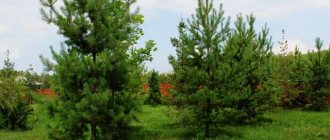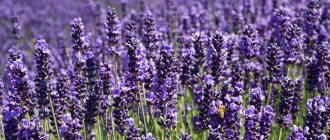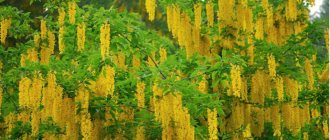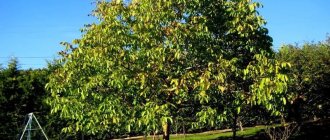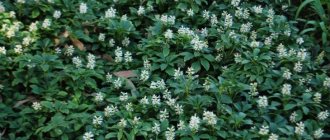Forsythia shrub is a true symbol of autumn: a spreading tree with bright yellow flowers. Caring for this plant before the onset of cold weather is especially important in the conditions of central Russia: forsythia needs pruning, feeding and shelter for the winter. It’s not difficult to make them, and we’ll talk about it right now.
Forsythia shrub is a true symbol of autumn: a spreading tree with bright yellow flowers
Technology for planting forsythia in autumn
In almost all cases, seedlings of this plant are planted in the autumn - in the first half of September. First of all, it is important to choose a location. To do this, several nuances are taken into account:
- Basically, you need to focus on the characteristics of a particular variety, which can differ greatly from each other.
- In general, forsythia prefer places that are exposed to the sun and not exposed to the wind.
- Regarding the composition of the soil, this shrub prefers neutral and light soils. If the soil is too acidic, ash should be added at the rate of 300-400 g per m2. Too heavy soil must be dug up first.
- Finally, you need to take care of the garden design; In addition, it is important to understand that forsythia grow greatly, so you should not skimp on the size of the space.
Features of planting and caring for forsythia in Siberia
If you plan to plant forsythia in Siberia, then it is necessary to provide the shrub with proper care, this is the only way the plant will delight with its appearance. In Siberia, forsythia is planted in places with little shade. It is also necessary to ensure that the site chosen for planting is protected from the wind. Often shrubs are planted near buildings or trees.
Soil enriched with microelements is ideal; humus is usually used for these purposes. Stagnation of moisture is not allowed, so the soil must be loose and well-permeable to air. If the soil is acidic or heavy, then it should be prepared in advance for planting forsythia.
Attention! If you do not provide proper care and allow groundwater to stagnate, the forsythia may die.
How to care for forsythia (video)
The composition of the soil with which the hole is filled is selected from the following components:
- part of humus;
- part of the leaf soil;
- 2 parts sand.
A hole is dug with a diameter of 60 cm (depth up to 70 cm), and you need to ensure that the roots of the seedling fit freely into it. Drain the hole quite strongly - you need to fill in at least 5-7 cm of crushed stone or broken brick. After this, the seedling is placed, covered with the mixture and watered with a standard 10-liter bucket of water.
NOTE
The distance between the pits depends on the variety, but the minimum is 1 meter (on average about 2 meters).
In almost all cases, forsythia seedlings are planted in the autumn - in the first half of September
Features of planting and caring for forsythia in the Urals
For each region, there are certain conditions for growing shrubs, so it is necessary not only to familiarize yourself with the photo of forsythia, but also with the rules of planting and care in the Urals. In the Urals, shrubs are planted in light soil, which is rich in humus and leaf soil. To lighten the soil, you can use expanded clay or river sand. It is important to understand that forsythia does not tolerate acidic soils.
The planting depth is about 70 cm, drainage up to 20 cm high is laid at the bottom of the hole, for this they use:
- broken building bricks;
- middle fraction expanded clay;
- sand.
To make the shrub grow faster, use top dressing and fertilizers, which are applied in the spring. Forsythia loves dry soils, so it is not recommended to overwater it.
Advice! The distance between bushes should be 2 m.
Features of preparing forsythia for winter
To properly prepare the shrub for the winter, you need to take into account a few simple rules for pruning, covering forsythia and other measures that guarantee successful wintering.
Also read: Protect from the cold: features of pruning and caring for spirea in autumn
Autumn pruning of forsythia
Any gardener who decides to grow this attractive shrub should have the skills of pruning forsythia, because it is thanks to this procedure that its lush, attractive shape can be constantly maintained. And autumn pruning also serves as an additional measure to preserve the plant during the winter. The pruning technology during this period is quite simple:
- First of all, dead branches, dried out, with cracked bark, as well as too long shoots that stand out noticeably against the general background, are removed.
- Next, remove all branches that are too close to the ground. Although a few of them can be left to root and propagate by layering (more details in the corresponding section). Then replant the scion and remove the rest of the shoot.
- All branches that grow towards the center, as well as intertwining ones located too close, are also completely removed: they will interfere with each other and spoil the overall appearance.
NOTE
Similar procedures are performed every season, and ideally it is better to prune immediately after the forsythia blooms.
Autumn pruning also serves as an additional measure to preserve forsythia during the winter period.
Sheltering forsythia for the winter
It is necessary to cover forsythia for the winter. Moreover, additional protective measures are used even in cases where winter-hardy varieties are involved. The only exceptions are the southern regions of the country - Kuban, Stavropol, the Caucasus and Crimea. The sequence of actions is as follows:
- First, the shrub needs to be watered abundantly, especially if it was planted this season.
- Next, the ground around the seedlings needs to be mulched with dry leaves and pine needles - the minimum layer is 10 cm.
- Then the branches are bent to the ground and pinned.
- Next, the bush is covered with spunbond and other material that allows sufficient moisture and air to pass through.
- The material is pressed down with heavy objects - it is better to find as many stones as possible, since the branches of forsythia are quite elastic.
Also read: Secrets of proper care of jasmine in autumn
NOTE _
You should not use polyethylene - otherwise the flower shoots will dry out during the thaw, which will negatively affect the growth and flowering of the shrub.
How to form a forsythia crown (video)
Other types of care for forsythia in the fall
Other measures to prepare forsythia for winter include mulching and fertilizer. Essentially, they are the same thing, because the mulch around the root collar is formed from humus from the compost. You can add dry foliage - ideally the layer should be 10-15 cm in height.
There is no need to apply mineral fertilizers - the plant is preparing for a dormant period, so such fertilizing is applied only in the spring. However, if the soil is too poor, you can fertilize it with organic matter.
How to plant forsythia in the Moscow region
Planting and caring for forsythia shrubs in the Moscow region is no different from planting plants in other regions. The first step is to prepare a planting hole, the depth of which is 60 cm and width 50 cm; broken brick, drainage and sand are poured into the bottom of the hole, for a total layer height of 10 cm.
When planting in groups, maintain a distance of 1.5-2 m between bushes. When planting in open ground in the fall, the soil is mulched, which will protect young forsythia from weeds, drying out and low temperatures.
Soil and planting site preparation
Growing forsythia is not as difficult as it might seem at first glance. The main thing is to know the characteristics of the shrub, prepare planting material and soil for planting in advance. As you know, the plant is unpretentious and can grow in any soil, but acidic soil is extremely undesirable.
If the soil is acidic, then it is necessary to add about 500 g of stove ash to each hole prepared for planting, after mixing it with fertile soil. Clay soils will require drainage. As a rule, they begin to plant in spring or autumn, until the cold weather sets in.
Seedling preparation
If the seedlings were obtained from cuttings, then they are planted the next year after they have been cut and formed a root system. If you plan to purchase seedlings, then you should pay special attention to this point. The purchased plants must not be damaged; the root system must be developed. Particular attention is paid to age; the older the forsythia, the worse it will adapt to new conditions after planting in open ground. To make the plant take root faster, you can treat the roots with a rooting agent.
Planting rules
To plant a bush, you will need to dig a hole, the size of which is 50*50*60 cm, the root system will be at a depth of 40 cm. If group planting is planned, then the distance between the bushes should be 1.5-2 m.
As a rule, a layer of drainage is laid at the bottom of the pit, which takes up 10 cm. Expanded clay and broken brick are excellent for these purposes, and sand is poured on top. Only after the hole has been prepared can the bush be planted, the soil compacted and watered abundantly.
If the plants are planted in the spring, then they do not need special care, but autumn plantings will have to be mulched. The material used for this must be breathable to prevent the kidneys from rotting.
Attention! It is necessary to take care in advance to prepare forsythia for winter in the fall.
Forsythia propagation technology in autumn
Most often, forsythia is propagated vegetatively and in the spring. However, if you do this in the fall, the bush has every chance of taking root. In this case, we are talking about the method of propagating forsythia using layering. The scheme is quite simple and will not take much time:
- First of all, you need to take into account that reproduction in the autumn period takes place at the beginning of September (for the southern regions it is possible at the end of September), so that the shoot has enough time to take root (3-4 weeks). You can also try this technology in July or August.
- First, the lowest (preferably young) shoot is bent to the ground, and a wire is wound at its base, which will additionally hold the branch in this position.
- The cuttings are sprinkled with soil - preferably fertile. If the soil is poor, you need to add a little humus or compost.
- The bark of the layer is cut from the side that is pressed to the soil and left in this form for the winter.
If you take into account all the rules, propagating forsythia by layering is quite simple: in the spring, the overgrown branch is completely cut off from the mother bush, making oblique cuts at the very base. Experience shows that forsythia blooms the very next season.
Propagating forsythia by layering is quite easy.
NOTE
Along with propagation by layering, cutting technology can also be used. At the end of September, lignified cuttings are cut and planted immediately in open ground. A few buds should be left above the surface of the earth. To prevent the cuttings from being damaged by frost, they are sprinkled with a layer of fallen leaves (10-15 cm).
Pruning and shaping forsythia
Nature colors forsythia in different shades: in spring – bright yellow, in summer – green, in autumn – golden purple. In order for a shrub to please with its appearance, it must be cared for in a timely manner. The main part of care is pruning forsythia in the fall.
Many gardeners know that forsythia is a fast-growing plant; it is for this reason that it is necessary to remove all excess in a timely manner. Otherwise, the plant will begin to overgrow at a rapid pace and lose its attractiveness. A neat, formed forsythia bush looks much better on the plots.
They begin pruning only after the plant has fully grown and grown, that is, after 4 years of growth. Often the bush is formed into a regular ball by cutting out branches that make the center dense.
The optimal time to remove excess and damaged branches is autumn. The main thing is not to overdo it during pruning, otherwise the plant will lose strength and will not be able to survive the winter. Experienced gardeners carry out work in early September.
In the spring, forsythia is inspected for branches damaged by frost. If there are any, then they should be removed. Particular attention must be paid to the ends; if there is damage, they are cut off.
Advice! If you do not have the necessary knowledge on how to properly remove shoots, then you should postpone pruning until the summer, when flowering comes to an end.
Young and branched shoots, as a rule, are only half removed. Old shoots begin to be removed in the spring, as bud formation begins in the fall. It is worth inspecting the forsythia bush for the presence of branches lowered to the ground; if there are any, they are removed. Otherwise, the rooting process will begin, and the plant will look untidy and spoil the entire appearance of the site.
It is recommended to rejuvenate forsythia every 4 years. In this case, all the shoots are removed, leaving only a small number of young shoots. This approach will allow the bush to grow much faster and bloom more abundantly.
Attention! The main care for forsythia is carried out in the fall.
Winter-hardy forsythia varieties for the Moscow region
For the climatic conditions of the Moscow region, winter-hardy forsythia varieties should be selected:
- Ovoid (oval) is the most suitable option, which is not only resistant to cold, but also to drought. It grows up to 2 meters in height, distinguished by gray bark with a yellowish tint. Blooms for 15-20 days. Moreover, by autumn the leaves turn from bright green to orange. Interestingly, many gardeners do not even cover it for the winter, but it is better to cover young seedlings with spunbond.
- A variety of the previous variety, Tetragold , is also characterized by increased winter hardiness. This species is suitable for lovers of miniature, lush plantings, since it grows no more than 1 meter.
- “Melissa” variety, which similar in properties to Tetragold, is compact and is well suited for small areas.
- Forsythia Siebold also tolerates winter very well, so it does not need additional shelter - just mulching the trunk is enough. The shrub is low-growing, its shoots spread along the ground. Prefers not open places, but light shading.
- Forsythia drooping is a rather tall shrub that grows up to 3 meters. But its flowering begins only after 5 years. The shoots are very interesting - they have an unusual olive or brown color. The branches need to be bent to the ground - in the conditions of the Moscow region they can freeze.
- Forsythia intermediate has approximately the same height, but begins to bloom at the age of 3. Gardeners very often use this variety to form hedges. Does not need additional shelter for the winter.
Also read: Winged euonymus: types and varieties, rules for caring for the plant
Forsythia blooming
During the flowering process, forsythia will not leave anyone indifferent. During this period, due to the abundant flowering, the shrub is completely covered with flowers of golden-yellow shades, which are shaped like bells. The appearance is simply mesmerizing. After the flowering period ends, the shrub does not lose its attractiveness. Bright flowers are replaced by bright foliage, which has a rich green color.
How forsythia blooms
Forsythia is an early flowering shrub, reaching a height of up to 2 m. The leaves are quite large, they can be simple or trifoliate, opposite, in some cases they can be serrated at the edges, and have a rich green color.
During the flowering process, rich golden colored bells appear. The flowers are of the same size, the branches are densely strewn. As a rule, the shrub begins to bloom in early spring and continues until the leaves appear. In regions with low temperature conditions, there is a possibility that some of the buds will die, and flowering will not be as abundant or will not occur at all. Therefore, it is recommended to cover the plant for the winter.
After flowering, forsythia turns into a bush with leaves of different shades and remains in this form until autumn, after which the next phase begins, during which the bush begins to fade. At the moment when forsythia begins to prepare for winter, it sheds all its leaves, changing its color. Despite the fact that after flowering forsythia loses its attractive appearance, in the fall the leaves acquire bright and varied shades. In autumn, foliage can be not only yellow, but also purple and burgundy.
We suggest you read: What do bats eat and where do they live?
There are several reasons why forsythia does not bloom:
- the soil is quite heavy and saline (in such conditions the shoots are poorly developed and the growth of the shrub is slow);
- there is stagnation of water in the hole;
- the process of pruning and shaping the bush was carried out incorrectly;
- there is a deficiency of nutrients in the soil;
- the kidneys froze in winter;
- pests appeared.
If these problems are eliminated, flowering occurs in 85% of cases. If, after taking all the measures to eliminate the problems, forsythia also grows slowly, then it is necessary to apply potassium fertilizer.
About the winter hardiness of forsythia
One of the most important characteristics of any perennial is its ability to tolerate low temperatures. In the case of forsythia, it is not possible to draw an unambiguous conclusion, since the species is represented by several selected varieties, the winter hardiness of which varies. Forsythia Ovate (Oval), Siebold and Drooping are considered the hardiest.
- Forsythia European - unsuitable for central Russia; in winter it needs a room that does not freeze;
- Forsythia Giralda - came from Northern China. This variety can be grown without insulation only in the southern part of Russia;
- Forsythia is medium - often grown in the middle zone with a temperate climate, but is not highly frost-resistant. To prevent the death of the plant, place it in a cool place in a large pot;
- Forsythia Greenest - suitable for growing exclusively in the southern regions.
Almost all species, even winter-hardy ones, need shelter during the cold season, if we are talking about regions such as Siberia and the Urals.
Video: “How to cover shrubs for the winter”
From this video you will learn how to properly cover shrubs for the winter.
Pruning must be carried out in accordance with the following requirements:
- remove all damaged or dead branches;
- get rid of excessively long shoots that clearly stand out from the overall picture;
- remove those shoots that are located as close as possible to the surface of the earth;
- trim those branches that grow in the center of the crown, as well as those that are located too close to each other.
Do not forget that pruning is necessary for the tree every year.
Shelter and mulching
It is necessary to protect forsythia from cold regularly, regardless of age and even plant variety. The first step is to mulch the tree trunk area - for this they use humus, laying it in a thick layer, at least 10 cm. After this, you can begin to organize a shelter for the entire bush: carefully bend the branches to the ground and cover them with spruce branches, cover them with dry leaves or cover them with any suitable insulating material.
Try to fix the branches at the surface of the ground before frost arrives, otherwise the shoots will lose their pliability. In the spring, when the last return frosts have passed, the covering layer can be removed and the bush freed - now it is ready to bloom again. Be sure to cover even those varieties of forsythia that are considered cold-resistant, because you never know how severe the winter will be.
Watering and fertilizing
Forsythia is one of those crops that do not require frequent watering - on the contrary, it does not tolerate excess moisture, so in the fall you don’t have to worry about moisture. During the rest of the time, the tree will only need one watering per month, and each plant will need to spend about 12 liters of water.
You can feed the bush with complex mineral fertilizer at the rate of 70 g of fertilizer per square meter of soil. It is necessary to carry out the procedure before starting mulching.
Some gardeners practice additional feeding with phosphorus and potassium to give the plant additional strength before wintering.
Shelter for frost
The characteristics of forsythia shelter for the winter depend on the climate of the growing region. For example, frost-resistant ornamental shrubs are not covered in the southern regions. In the Crimea, Stavropol Territory, Adygea and Krasnodar Territory, the Caucasus and Kuban, forsythia can winter without additional shelter. The plant is mulched with a mixture of peat, tree bark, sawdust and dry sand.
As for the central and northern regions, most species and varieties of ornamental garden crops are subject to shelter. In addition to mulching the root collar, you need to cover the entire shrub. To insulate forsythia, you can use “breathable” covering materials: spunbond, geofabric, lutrasil, etc. Opal leaves, dry soil, pine spruce branches and snow are poured on top of the covering material.
There are several methods for covering forsythia. Some gardeners build wooden frames that are covered with mesh or any non-woven covering material. Other gardeners prefer to bend the branches of the bush to the ground and then cover them. It is not recommended to use thick polyethylene film and roofing felt as covering materials.
Despite their high frost resistance, young and adult forsythia shrubs need to be insulated for the winter. Additional shelter protects not only from severe frosts, but also unexpected changes in air temperature.
Brief description of forsythia
Planting and caring for forsythia in the Moscow region involves taking into account all its characteristics. This is a garden shrub with a trunk covered with rough dark brown bark. The shoots form a spreading crown with a diameter of 2 meters. The leaves are oval-shaped, yellow or bright green, 10-15 cm long. The flowers are bell-shaped and colored orange, white or yellow. They are arranged in small bunches. The fruits are filled with winged seeds. Depending on the variety and species, the height of an adult plant varies from 1 to 2.5 m.
Flowering begins in early spring, before the leaves bloom, and lasts about a month. The culture is undemanding to soil, resistant to hot weather, frost and pests. In general, the plant is unpretentious, but prefers well-lit areas.
There are several types of forsythia, which differ from each other in external parameters. These include:
- drooping;
- ovoid;
- intermediate;
- dark green;
- European;
- average.
In the Moscow region, only the first three varieties are common.
The most suitable forsythia varieties for the Moscow region:
- Variegata;
- Fortune;
- Siebold;
- Lindwood;
- Beatrix Farrand;
- Fiesta.
Types of forsythia
The genus Forsythia includes 13 species and many varieties that are similar in biological characteristics. For planting in gardens in central Russia, hanging or drooping forsythia (Forsythia suspensa), f. intermediate, or hybrid (Forsythia × intermedia) and f. oval-leaved or ovoid (Forsythia ovata).
You can find various varieties of intermediate forsythia on our market, where products from various online stores are presented. View a selection of forsythia seedlings.
